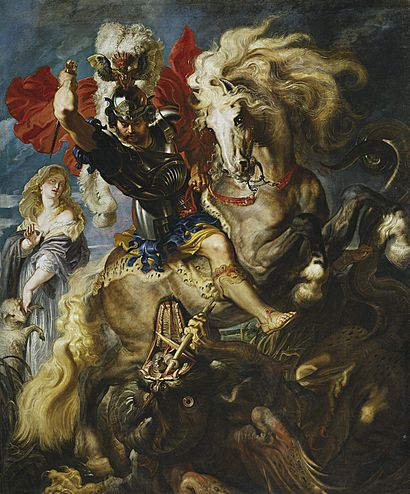Saint George and the Dragon (Rubens) facts for kids
Quick facts for kids Saint George and the Dragon |
|
|---|---|
 |
|
| Artist | Peter Paul Rubens |
| Year | ca. 1605–07 |
| Medium | Oil on canvas |
| Dimensions | 309 cm × 257 cm (122 in × 101 in) |
| Location | Museo del Prado, Madrid |
The painting Saint George and the Dragon was created by the famous artist Peter Paul Rubens around 1605–1607. It shows the classic story of Saint George fighting a dragon.
Rubens painted this artwork while he was in Italy. He was there to learn more about art and improve his skills. He painted it in Genoa, a city where Saint George is a very important patron saint. Some art experts believe the painting was meant for a church in Genoa. However, Rubens kept the painting until he passed away in 1640. Later, a king bought the artwork. Today, you can see it at the Museo del Prado museum in Madrid, Spain.
What the Painting Means
This painting is full of symbols that tell a deeper story.
The Characters and Their Meanings
- The Princess: In the painting, the princess stands for the church.
- The Lamb: The scared lamb next to her represents the innocence and purity of Jesus Christ. He is often called the "Lamb of God."
- Saint George and His Horse: Saint George and his powerful horse show how good triumphs over evil. Saint George is ready to strike down the dragon from above. His right foot is clearly shown above the dragon. This means that the dragon, which represents darkness and evil, is completely beneath Saint George and the light around him.
The Dragon's Symbolism
The dragon in the painting looks more like a snake than a typical lizard or dinosaur. This is a special hint to an old Bible story. In that story, Satan takes the form of a serpent. So, the dragon here also represents the devil and evil.
See also
 In Spanish: Lucha de San Jorge y el dragón (Rubens) para niños
In Spanish: Lucha de San Jorge y el dragón (Rubens) para niños

